The 2023 Emerging Leader in Atomic Spectroscopy Award
This year’s Atomic Spectroscopy Award recipient is Andreas Riedo. For the past decade, Riedo’s research has focused on the development of fundamental measurement methodologies using miniaturized laser ablation–desorption ionization mass spectrometry (LIMS or LMS) for the chemical (elements, isotopes, and molecules) analysis of complex mineral surfaces, including semiconductor crystalline solids and materials found in space exploration.
Andreas Riedo of the Physics Institute at the University of Bern has won the 2023 Emerging Leader in Atomic Spectroscopy Award, which is presented by Spectroscopy magazine. This annual award, begun in 2017, recognizes the achievements and aspirations of a talented young atomic spectroscopist, selected by an independent scientific committee. The award will be presented to Riedo at the 2023 European Winter Conference on Plasma Spectrochemistry (Ljubljana, Slovenia, January 29–February 3, 2023), where he will give an award lecture.
Andreas Riedo of the Physics Institute at the University of Bern, Switzerland.

Riedo’s research has focused on the development of fundamental measurement methodologies using laser ablation (LA) and laser ablation–desorption ionization mass spectrometry (LIMS) for the chemical analysis of complex solid materials and organic molecules that are related to space research and astrobiology.
Riedo received his PhD in physics in 2014 and has been actively involved in the field of space research and planetary exploration, focusing on the design, development, and qualification of space-capable analytical instrumentation. His interest and work in the field of laser-based MS began during his PhD studies with Prof. Peter Wurz at the Physics Institute in the division of Space Research and Planetary Sciences at the University of Bern. As a graduate student, Riedo optimized an existing LIMS system intended for in situ space research. The instrument was enhanced as a result of his work to perform analysis for quantitative element composition, isotope abundances, depth profiling, and two- and three-dimensional (3D) chemical imaging and analysis.
As a postdoctoral researcher, Riedo specialized in applying LIMS for potential astrobiology applications. Specifically, this research seeks to identify chemical biosignatures that may indicate past or present occurrence of life forms in extraterrestrial environments. To further advance the techniques required for detection of current extraterrestrial life, Riedo has measured carbon, hydrogen, nitrogen, oxygen, phosphorus, and sulfur (CHNOPS) biomarkers in selected terrestrial desert soil samples. He has demonstrated single-microbe detection in such soil samples for sparse life identification. In addition, he has shown that sensitive LIMS is capable of accurate isotope ratio analysis of sulfur isotopes, which are an important class of potential life biomarkers.
After his postdoctoral work, Riedo built his own laboratory as an indepen- dent scientist at the University of Bern, where he has applied laser desorption mass spectrometry to detect complex molecules potentially relevant for Earth-like lifeforms. These molecule types include polycyclic aromatic hydrocarbons (PAHs), lipids, and amino acids. Currently, Riedo is a scientist and project manager for the Neutral gas and Ion Mass spectrometer (NIM) instrument, which is part of the scientific payload of the Jupiter’s Icy Moons explorer (JUICE) space mission of the European Space Agency (ESA).
The Laser Mass Spectrometry Laboratory, an ISO 5 cleanroom, in spring 2022, showing Andreas Riedo in the foreground and his PhD student Peter Keresztes Schmidt in the background. They are working on the refurbishment of the ion-optical part of the LIMS (LMS) instrument. The detector unit with the bottom part of the ion-optical elements is directly in front of them, and the top part of the ion-optical instrument is to the front-right (the metallic tubular structure with the white ring on top). (Photo courtesy of Peter Wurz).
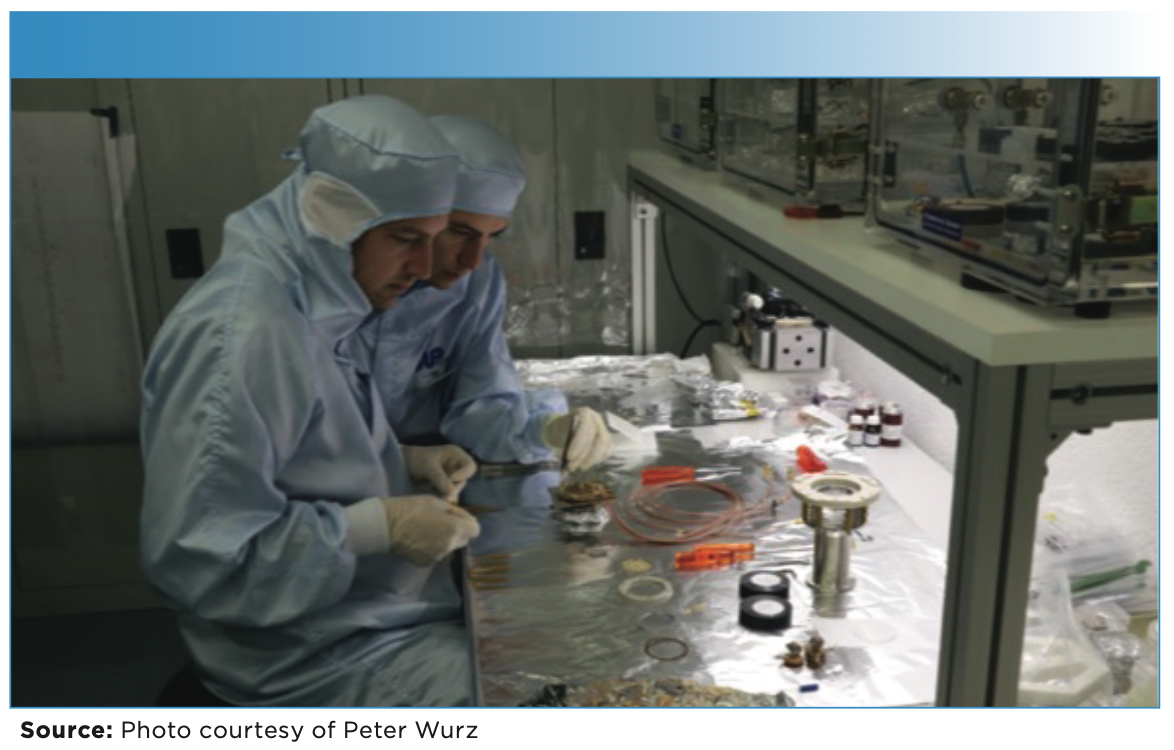
Riedo at work in The Laser Mass Spectrometry Laboratory in 2022. (Photo courtesy of Andreas Riedo).
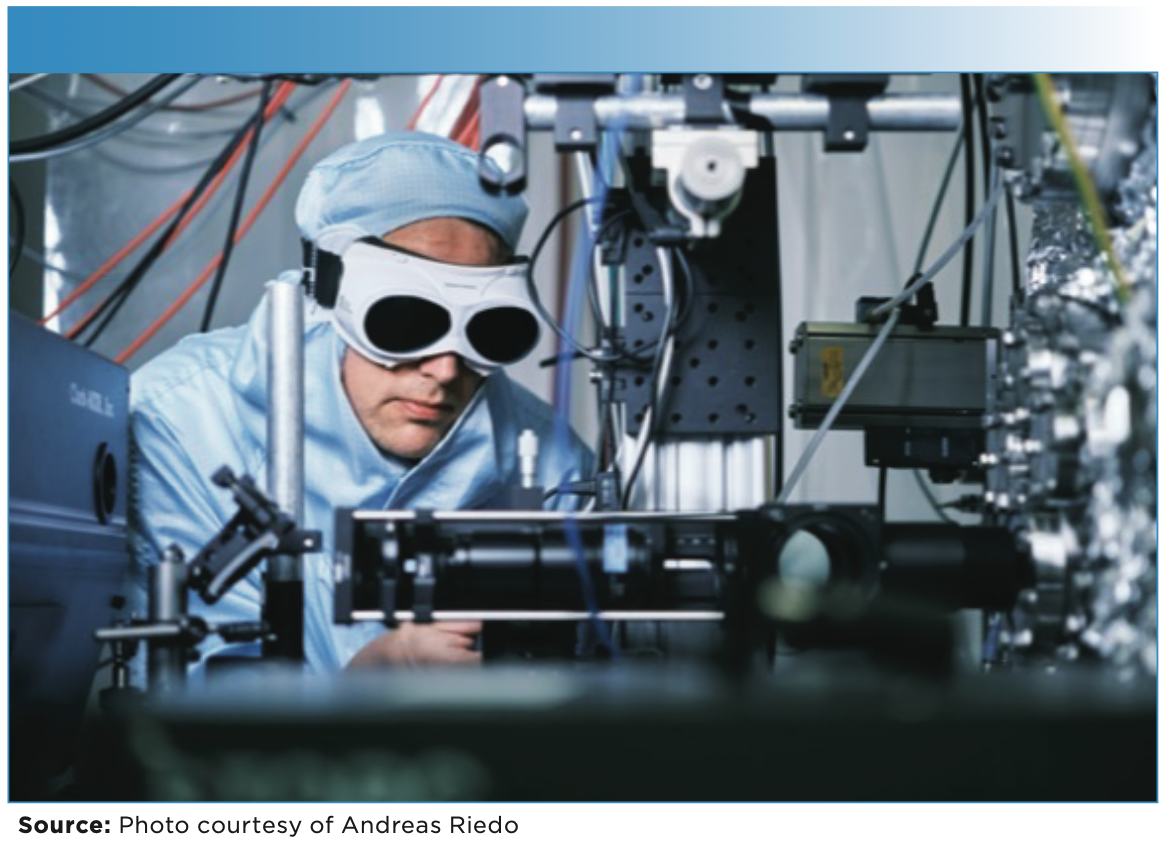
Developing and Refining Instrumentation to Advance Astrobiology: a Miniature Laser Ablation Time-of-Flight Mass Spectrometer
Riedo has gained significant recognition in the field of experimental astrobiology. He was invited to join the studies group for instrumentation that will be part of the National Aeronautics and Space Administration (NASA) Europa Lander. His instrument project for a potential future mission would look for signs of life on the surface of Europa, one of Jupiter’s moons. Europa is slightly smaller than Earth’s moon and is primarily made of silicate rock with a water-ice crust. He is also a project manager for two LIMS instruments planned for NASA’s Artemis program on the moon. The Artemis program will land the first woman and next man on the moon by 2024 and test new technologies and approaches to gather information for sending astronauts to Mars. In addition, his Organics Information Gathering Instrument (ORIGIN) has been selected for a mission to Venus (8). “The ORIGIN space instrument is a miniature laser desorption–laser ablation ionization mass spectrometry (LIMS) instrument designed to detect large, non-volatile molecules, specifically biomolecules such as amino acids and lipids; as well as to be used in ablation mode for elemental composition analysis of extraterrestrial materials. Being able to successfully achieve an innovative system to be included on a Venus Life Finder Mission is a significant contribution,” said Jorge Pisonero of the University of Oviedo in Spain.
“Dr. Andreas Riedo designed and constructed independently a novel mass spectrometric setup based on laser desorption mass spectrometry,” Pascale Ehrenfreund from George Washington University said. “Riedo’s instrument allows the direct desorption of biomolecules that are highly relevant for life detection on planetary objects other than Earth.” When addressing Riedo’s most important contributions, Frances Westall from the CNRS-Centre de Biophysique Moléculaire in Orléans, France said. “His space-developed instrumentation is capable of providing the essential context information from a rock sample potentially hosting carbonaceous traces of life, then analyzing these specific traces.”
The AbSciCon Conference in May 2022 showing Riedo (right) with PhD student Nikita Boeren (left). (Photo courtesy of Andreas Riedo).
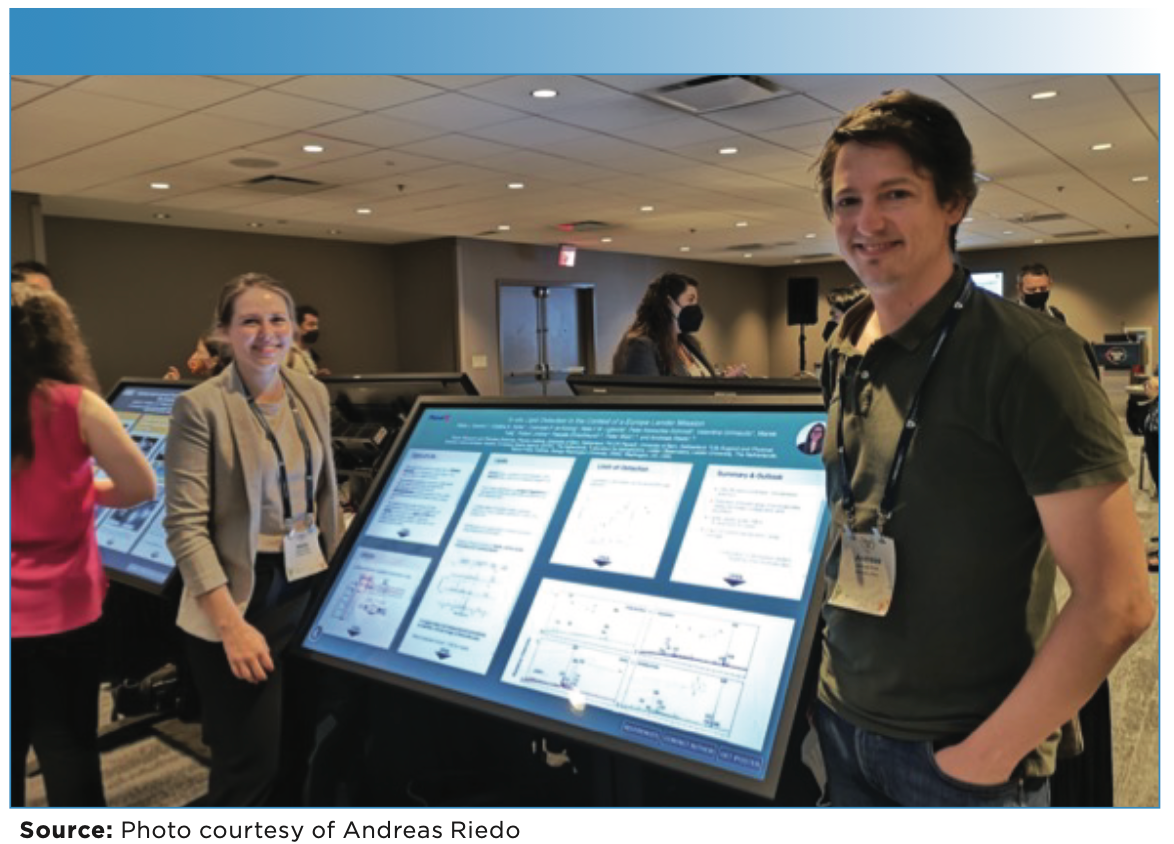
Developing the Miniature Laser Ablation Time‐of‐Flight Mass Spectrometer
Indeed, colleagues and the community at large are impressed by Riedo’s work on instrumentation for space exploration. “Riedo has proven his abilities to develop innovative new methods to study samples from other planetary environments,” notes Charles Cockell, a collaborator from the University of Edinburgh. Riedo’s paper reporting on the analytical performance of a miniature LMS designed for in situ investigations of planetary surfaces is his most cited paper to date (1) (Table I). The high sensitivity and high spatial resolution mass spectrometer for this instrument was designed for elemental and isotopic analysis of naturally occurring materials. An UV laser, rather than infrared (IR), was used for sample ablation with an irradiance of ~1 GW/cm2. Implementing this laser achieved stable ion formation with low sample weight loss. This instrument exhibited good reproducibility because of the use of computer control of the experimental parameters, such as laser ablation characteristics, ion-optical parameters, and sample position. The dynamic range of the instrument was reported to be more than eight decades, and the detection sensitivity for both metallic and non-metallic elements was excellent. Abundance down to tens of parts per billion (ppb) was demonstrated together with detailed isotopic patterns. This instrument has demonstrated improved performance over established instruments in planetary in situ research. “This very compact instrument shows much better performance than instrumentation used so far in planetary research,” said Peter Wurz, Riedo’s doctoral supervisor and mentor at the Physics Institute at the University of Bern in Switzerland said. “None of the established instruments in planetary in situ research has such performance.”
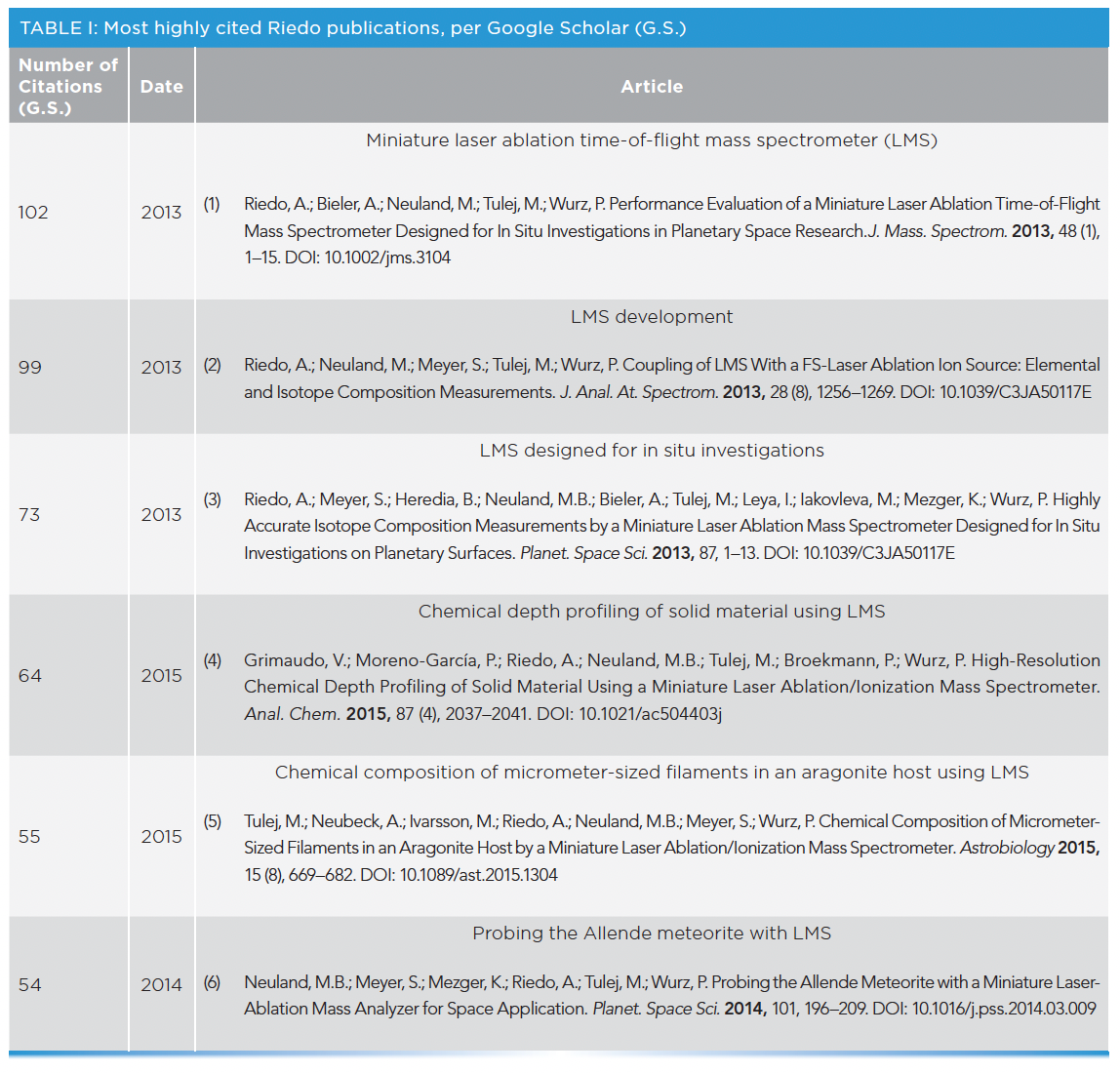
As part of this work, Riedo and his colleagues reported the first mass spectrometric analysis of elemental and isotopic composition of several National Institute of Standards and Technology (NIST) standards using their miniature LMS (2). This research demonstrates improvements to previous LMS systems by varying laser optics, type and wavelength, as well as data acquisition and analysis procedures. The selected femtosecond (fs)-laser ablation ion source used was a 775 nm, 190 fs, 1 kHz laser, which has exhibited reduced thermal effects and negligible sample damage, as well as substantial improvements in instrument performance, as discussed above. This work, which shows the successful introduction of femtosecond lasers in his mass spectrometry instrument, stands out to Wurz. “This paper is exemplary for the continuous development by Andreas Riedo of the analytical improvements he has pursued,” Wurz said.
In 2013, Riedo and coworkers expanded the use of the miniature LMS for precise and accurate measurements of isotope abundances (3). A pulsed UV laser (266 nm, 3 ns, and 20 Hz) was applied for ablation, atomization, and ionization for measurements of several untreated NIST standards and to measure galena, a naturally occurring mineral form of lead(II) sulfide. Relative accuracy and precision for this instrument for these samples was shown to be in the parts-per-thousand level. The results for galena were surprisingly similar to those obtained using a thermal ionization MS (TIMS) system. It was determined that a lower isotope composition in the sample (for example below 100 ppm), resulted in a measured accuracy and precision in the percentage levels. The instrument is able to estimate the age of minerals using measurements of the lead isotope 207Pb/206Pb ratio.
Work published from 2017 demonstrated the importance of high-speed and high dynamic range detector systems for optimum resolution and sensitivity time-of-flight MS (12). To achieve the appropriate analytical performance, a multi-anode multichannel plate detector with high-speed data acquisition was tested. This design resulted in a lightweight, low power, compact detector system that was suitable for portable or space payload instrumentation.
Analysis of rock and soil samples on extraterrestrial planets is an important part of upcoming space missions. To that end, Riedo and collaborators reported on the development and testing of a miniaturized LMS for in situ spatial and elemental profiles of a heterogeneous rock sample to a depth of several nanometers (17). This work demonstrated that highly detailed 3D composition information, including oxidation properties could be obtained for natural, heterogeneous rock samples by applying the LMS technology. When combined with Raman spectroscopy, LMS provides even more comprehensive mineralogical analysis details. These details are important for characterization and determination of probe drilling locations that will yield the greatest information on remote planet landscapes.
The Atacama desert, representing a terrestrial Mars analogue site, in September 2019. (Photo courtesy of Andreas Riedo).
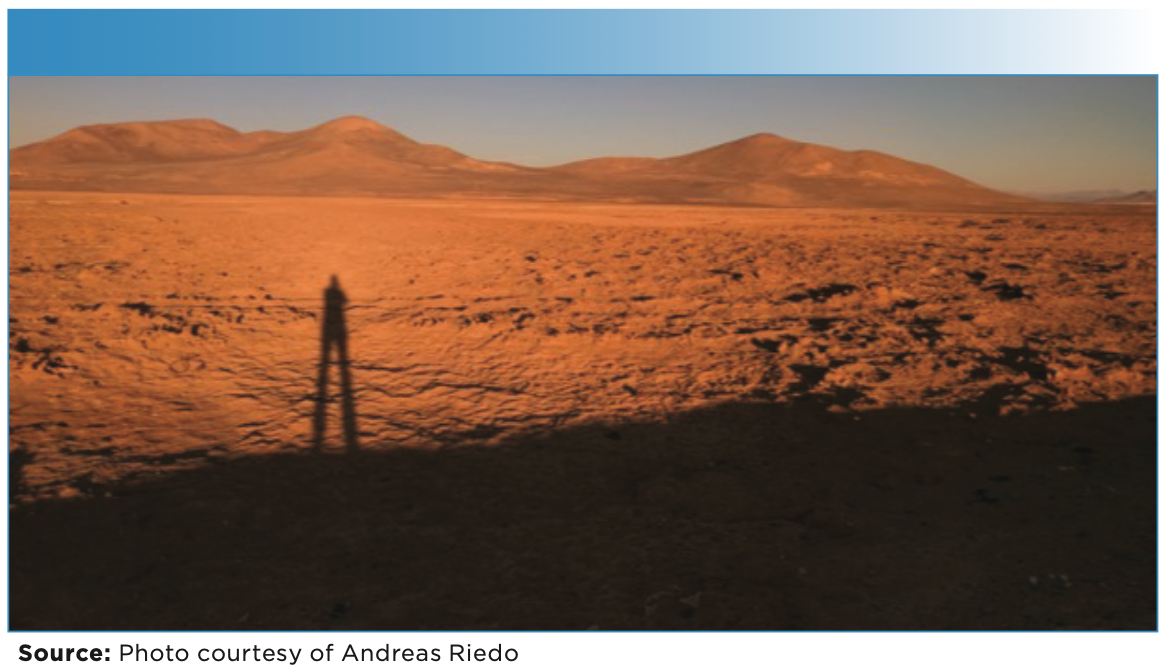
Riedo performing field work in the Atacama desert (as a Mars analogue site) in September 2019. (Photo courtesy of Andreas Riedo).
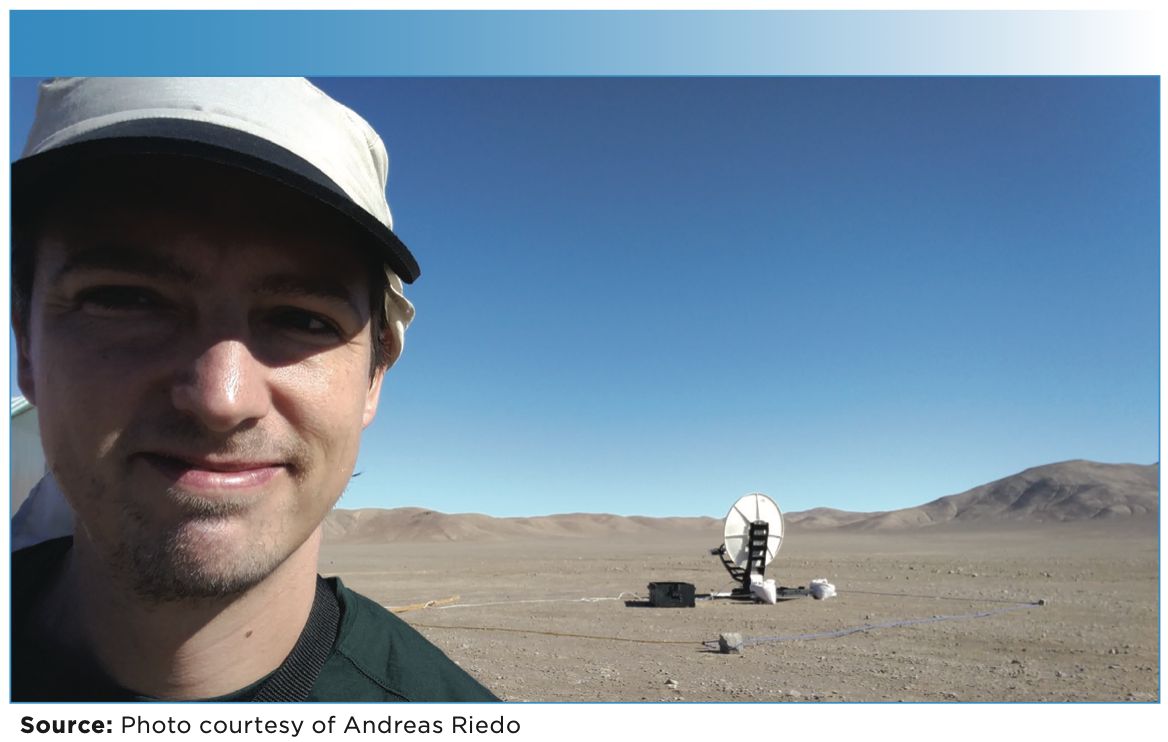
The most recent developments of instrumentation and applications carried out by Riedo and coworkers has been for the detection of lipids, sulfur isotopes, elemental signatures of microbes, and amino acids on extraterrestrial and planetary analogue surfaces (7,9,10–11). These most recent publications are listed in Table II. This research further addresses advanced applications of LIMS, LMS, and Raman spectroscopy for materials characterization, such as 3D chemical imaging, structural analysis of contaminants in electrodeposited metal films, chemical depth profiling of solid materials, and in situ analysis of elemental and isotopic composition of heterogeneous materials, such as meteorites, and terrestrial rocks and minerals.

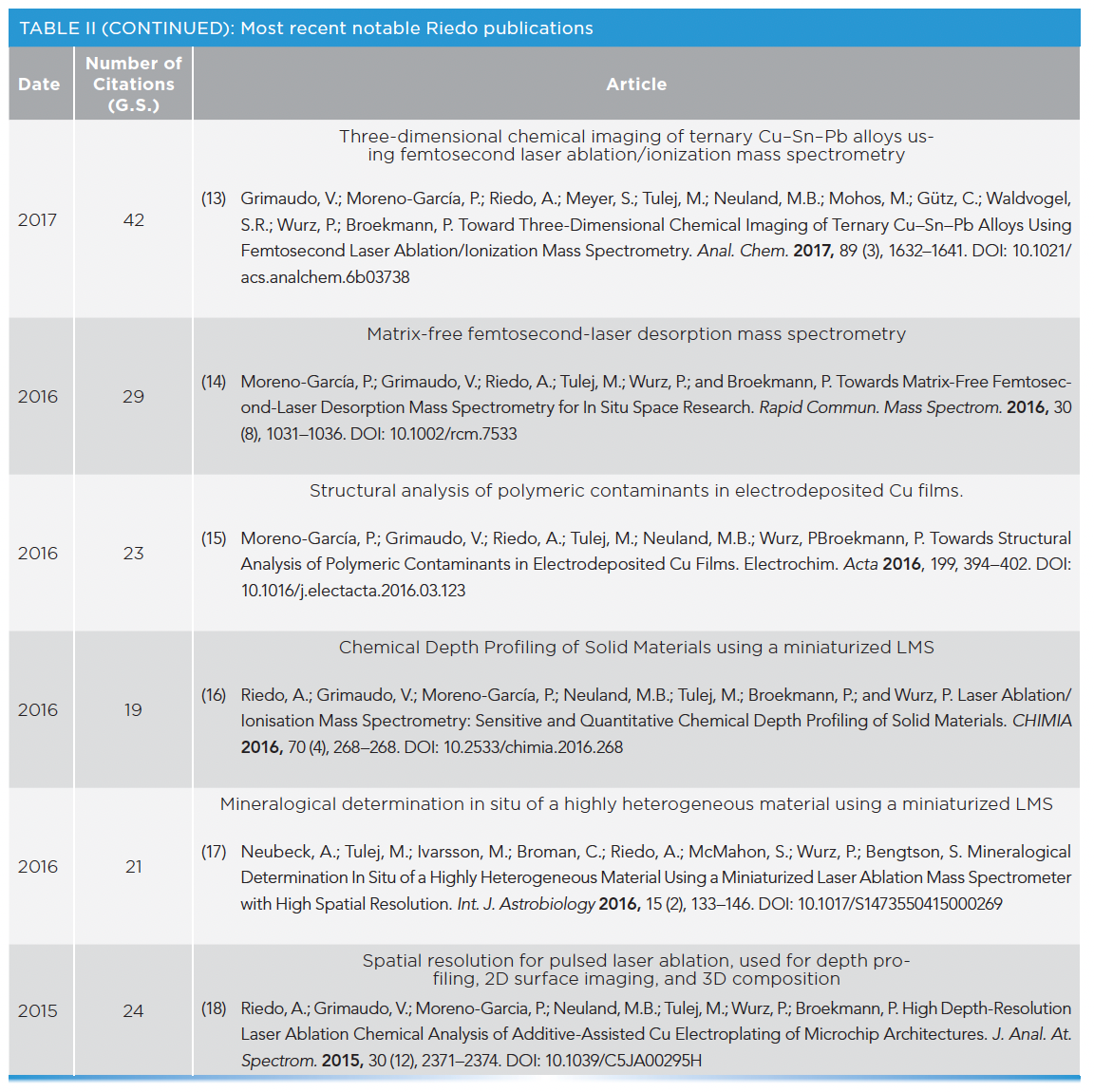
Chemical Imaging
Riedo and colleagues have demonstrated that chemical imaging of metallic samples is possible using fs LIMS, with results in agreement with inductively coupled plasma–collision/reaction interface–mass spectrometry (ICP–CRI-MS) and laser ablation–inductively coupled plasma–mass spectrometry (LA-ICP-MS). Riedo’s work has been applied to probe the spatial element composition of three ternary Cu–Sn–Pb model bronze alloys (lead bronzes: CuSn10Pb10, CuSn7Pb15, and CuSn5Pb20) (13). These alloys were selected as representing excellent cathode materials used for electro-organic synthesis involving dehalogenation or deoxygenation of pharmaceutical products. The chemical imaging was performed using spotwise measurements, by ablating material from various surface locations using a 4 × 4 raster array (50 μm pitch distance, with each ablation crater diameter of ~20 μm). Major elements (Cu, Sn, and Pb), minor elements (Ni, Zn, Ag, and Sb) and trace elements (C, P, Fe, and As) were quantified and available for constructing elemental image generation of the solid samples.
Chemical Analysis Using a Miniature Laser-Ablation Mass Analyzer
Part of the work being done by Riedo and coworkers to advance instrumentation for space exploration is to ensure its capability to detect potential extraterrestrial life. The detection of the signs of life on other planets involves the analysis of rock and soil samples for chemical and isotopic composition. Riedo and colleagues have described the method and apparatus for analysis of the chemical composition of naturally occurring microfossils using their miniature LMS system approach (5). The reported chemical analysis studies were conducted with high spatial resolution of approximately 15 μm W x 20–200nm H. The purpose of this investigation was to evaluate micrometer-sized samples for isotope abundance, isotope ratios, and element composition—and to summarize the analysis data into accurate chemical compositional maps of these samples. Results for the chemical mapping were successful, noting that an improved signal to noise ratio is required for accurate isotope ratio determination.
An LMS, designed and built at the University of Bern in the Department of Space Research and Planetary Sciences, was used to measure and characterize the elemental composition, mineralogy, and petrology of an Allende meteorite sample (6). This experiment demonstrated the feasibility for applying LMS to analyze rock samples for remote extraterrestrial applications. The mineralogical and volatile element content of the Allende meteorite—the largest carbonaceous chondrite ever found on Earth, composed mainly of silicates, oxides and sulfides, graphite, carbonates and organic compounds, including amino acids—was able to be accurately determined without sample preparation.
Field studies have been conducted by NASA teams in the Atacama desert (as a Mars analogue site), as part of the Subglacial Lake Exploration: Diversity, Geochemistry, Ecology (SLEDGE) project of the European Union to determine if Earth-based microbes of sparse life in soil samples could be detected based on element analysis (10). The purpose of this study was to test and improve the measurement capabilities of the miniature LMS instrument designed by Riedo and coworkers. For the study, 14 Martian mudstone analogue samples were used—half artificially inoculated with microbes, and half used as abiotic controls. The samples were treated in four different ways—biotic samples were cultured anaerobically and aerobically; abiotic samples were incubated with water, and some remained dry. A few of the samples were irradiated with a high dose of gamma radiation, while others were not irradiated. The study demonstrated that their instrumentation is capable of detecting microbes of sparse life in terrestrial soil samples. “This demonstrated capability allowed him to become a member of NASA teams for field studies in Mars analogue sites,” Wurz said. In summary, this research showed the first results on the detection of biogenic element patterns of microbial life using a miniature, space-mission-capable LIMS system.
In 2016, Riedo and his colleagues determined that direct laser desorption MS (LD-MS) was capable of measuring low molecular weight biomarkers in geological samples (14). It was following this 2016 work that the miniature LMS was first designed, built, and tested for in situ elemental and isotope analysis of solids in space research.
Chemical Depth Profiling of Solid Materials
The miniature LMS system has also been developed for applications on earth, such as chemical depth profiling of solid materials. In 2015, LMS was used for high-resolution chemical depth profiling measurements of copper films as a feasibility study to determine its spatial analysis capabilities for semiconduc- tor wafer plating and surfaces of space weathered samples (4). For this work, the custom-developed LMS used an ultrashort pulsed laser system (τ ~ 190 fs, λ = 775 nm) for ablation and ionization of the sample surface with a subnanometer ablation rate per single laser shot. The instrument demonstrated capabilities for high vertical depth resolution, excellent sensitivity (near 10 ppb), and a dynamic range greater than 108.
In early 2016, Riedo published work describing the structural analysis of plating additives in copper films using LIMS combined with secondary ion mass spectrometry (SIMS) and focused ion beam (FIB) analysis for sample depth profiling of electrodeposited copper films (15). The LIMS technique demonstrated nanometer depth-resolution. Using the combined analytical techniques allowed for a detailed assessment of the additive’s interaction and location within the copper films.
Another published paper by Riedo in 2016 was able to demonstrate high spatial resolution using LMS for direct chemical quantitation of solids (16). In recent years, the analytical methods of choice for chemical analysis of solid materials have been SIMS, LA-ICP-MS, and glow discharge MS (GD-MS). For remote space measurements and for characterization of materials used for manufacturing semiconductors, a miniaturized LMS instrument also provides high spatial resolution measurements of such solids as metal alloys, meteorite specimens, and terrestrial fossils.
In 2015, Riedo and associates published the first paper where pulsed laser ablation was used for high spatial resolution depth profiling for solid materials (18). This work was expanded to two-dimensional surface imaging, and then to 3D composition profiling of solids. These profiles have been shown to demonstrate a nanometer scale vertical spatial resolution, while providing chemical composition information. Such a technique provides detailed information for metal layering and deposition processes as well as solid materials and geological samples.
Personal Qualities
People always seem to be interested in what makes some individuals so successful. Is it personality, enthusiasm, brilliance, work ethic, organizational skills, communication skills, or the ability to network and successfully establish important collaborative relationships in one’s field? In Riedo’s case, he clearly possesses many of these qualities.
“Andreas is a super enthusiastic person with a great knowledge about his research topics,” Pisonero said. “Andreas is an incredibly friendly person, very talkative and with great communication skills.”
“Andreas is really a hands-on person, gets fully involved in all experimental aspects and data analysis,” Wurz said. “He is also good in including students in his research, from the bachelors level all the way to PhD students.” Wurz further elaborates, “Andreas has strong networking capabilities and successfully established important collaborations in Europe and the US in the research field of astrobiology.”
“I am generally impressed by Andreas’s energy, intelligence and pursuit of his objectives,” Westall said. “In this, he is a hard worker but is also companionable and enjoys social interaction.”
“Dr. Andreas Riedo has a very positive attitude and is always constructive. He is hard working, decisive, and perseverant,” Ehrenfreund said. “He is a very positive and pragmatic person and extremely good at multitasking. He is very dedicated to outreach, which is a rare and important quality for researchers today.”
Westall summed up the feelings of several collaborators: “I am happy to have to opportunity to know and work with Andreas,” he said. “I appreciate his youthful enthusiasm, dynamism and drive. I hope, one day, to see his instruments flying!”
References
(1) Riedo, A.; Bieler, A.; Neuland, M.; Tulej, M.; Wurz, P. Performance Evaluation of a Miniature Laser Ablation Time‐of‐Flight Mass Spectrometer Designed for In Situ Investigations in Planetary Space Research. J. Mass. Spectrom. 2013, 48 (1), 1–15. DOI: 10.1002/jms.3104
(2) Riedo, A.; Neuland, M.; Meyer, S.; Tulej, M.; Wurz, P. Coupling of LMS With a FSLaser Ablation Ion Source: Elemental and Isotope Composition Measurements. J. Anal. At. Spectrom. 2013, 28 (8), 1256–1269. DOI: 10.1039/C3JA50117E
(3) Riedo, A.; Meyer, S.; Heredia, B.; Neuland, M.B.; Bieler, A.; Tulej, M.; Leya, I.; Iakovleva, M.; Mezger, K.; Wurz, P. Highly Accurate Isotope Composition Measurements by a Miniature Laser Ablation Mass Spectrometer Designed for In Situ Investigations on Planetary Surfaces. Planet. Space Sci. 2013, 87, 1–13.
(4) Grimaudo, V.; Moreno-Garc.a, P.; Riedo, A.; Neuland, M.B.; Tulej, M.; Broekmann, P.; Wurz, P. High-Resolution Chemical Depth Profiling of Solid Material Using a Miniature Laser Ablation/Ionization Mass Spectrometer. Anal. Chem. 2015, 87 (4), 2037–2041. DOI: 10.1021/ac504403j
(5) Tulej, M.; Neubeck, A.; Ivarsson, M.; Riedo, A.; Neuland, M.B.; Meyer, S.; Wurz, P. Chemical Composition of Micrometer-Sized Filaments in an Aragonite Host by a Miniature Laser Ablation/Ionization Mass Spectrometer. Astrobiology 2015, 15 (8), 669–682. DOI: 10.1089/ast.2015.1304
(6) Neuland, M.B.; Meyer, S.; Mezger, K.; Riedo, A.; Tulej, M.; Wurz, P. Probing the Allende Meteorite with a Miniature Laser-Ablation Mass Analyzer for Space Application. Planet. Space Sci. 2014, 101, 196–209. DOI: 10.1016/j.pss.2014.03.009
(7) Boeren, N.J.; Gruchola, S.; de Koning, C.P.; Keresztes Schmidt, P.; Kipfer, K.A.; Ligterink, N.F.W.; Tulej, M.; Wurz, P.; Riedo, A. Detecting lipids on planetary surfaces with laser desorption ionization mass spectrometry. Planet. Sci. J. (2022), in press.
(8) Ligterink, N.F.; Kipfer, K.A.; Gruchola, S.; Boeren, N.J.; Keresztes Schmidt, P.; de Koning, C.P.; Tulej, M.; Wurz, P.; Riedo, A. The ORIGIN Space Instrument for Detecting Biosignatures and Habitability Indicators on a Venus Life Finder Mission. Aerospace 2022, 9 (6), 312. DOI: 10.3390/aerospace9060312
(9) Riedo, A.; Grimaudo, V.; Aerts, J.W.; Lukmanov, R.; Tulej, M.; Broekmann, P.; Lindner, R.; Wurz, P.; Ehrenfreund, P. Laser Ablation Ionization Mass Spectrometry: A Space Prototype System for In Situ Sulphur Isotope Fractionation Analysis on Planetary Surfaces. Front. Astron. Space Sci. 2021, 8, 1–12. DOI: 10.3389/fspas.2021.726373
(10) Riedo, A.; de Koning, C.; Stevens, A.H.; Cockell, C.S.; McDonald, A.; Cede Lopez, A.; Grimaudo, V.; Tulej, M.; Wurz, P.; Ehrenfreund, P. The Detection of Elemental Signatures of Microbes in Martian Mudstone Analogues Using High-Spatial Resolution Laser Ablation Ionization Mass Spectrometry. Astrobiology 2020, 20, 1224–1235. DOI: 10.1089/ast.2019.2087
(11) Ligterink, N.F.W.; Grimaudo, V.; Moreno-Garcia, P.; Lukmanov, R.; Tulej, M.; Leya, I.; Lindner, R.; Wurz, P.; Cockell, C.S.; Ehrenfreund, P.; Riedo, A. ORIGIN: A Novel and Compact Laser Desorption–Mass Spectrometry System for Sensitive In Situ Detection of Amino Acids on Extraterrestrial Surfaces. Nature Sci. Rep. 2020, 10, 9641. DOI: 10.1038/s41598-020-66240-1
(12) Riedo, A.; Tulej, M.; Rohner, U.; Wurz, P. High-Speed Strip-Line Multi-Anode Multichannel Plate Detector System. Rev. Sci. Instrum. 2017, 88, 045114. DOI: 10.1063/1.4981813
(13) Grimaudo, V.; Moreno-Garc.a, P.; Riedo, A.; Meyer, S.; Tulej, M.; Neuland, M.B.; Mohos, M.; Gütz, C.; Waldvogel, S.R.; Wurz, P.; Broekmann, P. Toward Three-Dimensional Chemical Imaging of Ternary Cu–Sn–Pb Alloys Using Femtosecond Laser Ablation/Ionization Mass Spectrometry. Anal. Chem. 2017, 89 (3), 1632–1641. DOI: 10.1021/acs.analchem.6b03738
(14) Moreno-Garc.a, P.; Grimaudo, V.; Riedo, A.; Tulej, M.; Wurz, P.; and Broekmann, P. Towards Matrix-Free Femtosecond-Laser Desorption Mass Spectrometry for In Situ Space Research. Rapid Commun. Mass Spectrom. 2016, 30 (8), 1031–1036. DOI: 10.1002/rcm.7533
(15) Moreno-Garcia, P.; Grimaudo, V.; Riedo, A.; Tulej, M.; Neuland, M.B.; Wurz, Broekmann, P. Towards Structural Analysis of Polymeric Contaminants in Electrodeposited Cu Films. Electrochim. Acta 2016, 199, 394–402. DOI: 10.1016/j.electacta.2016.03.123
(16) Riedo, A.; Grimaudo, V.; Moreno-Garcia, P.; Neuland, M.B.; Tulej, M.; Broekmann, P.; and Wurz, P. Laser Ablation/Ionisation Mass Spectrometry: Sensitive and Quantitative Chemical Depth Profiling of Solid Materials. CHIMIA 2016, 70 (4), 268–268. DOI: 10.2533/chimia.2016.268
(17) Neubeck, A.; Tulej, M.; Ivarsson, M.; Broman, C.; Riedo, A.; McMahon, S.; Wurz, P.; Bengtson, S. Mineralogical Determination In Situ of a Highly Heterogeneous Material Using a Miniaturized Laser Ablation Mass Spectrometer with High Spatial Resolution. Int. J. Astrobiology 2016, 15 (2), 133–146. DOI: 10.1017/S1473550415000269
(18) Riedo, A.; Grimaudo, V.; Moreno-Garcia, P.; Neuland, M.B.; Tulej, M.; Wurz, P.; Broekmann, P. High Depth-Resolution Laser Ablation Chemical Analysis of Additive-Assisted Cu Electroplating of Microchip Architectures. J. Anal. At. Spectrom. 2015, 30 (12), 2371–2374. DOI: 10.1039/C5JA00295H
About the Author
Jerome Workman, Jr. is the Senior Technical Editor for Spectroscopy. Direct correspondence about this article to jworkman@mjhlifesciences.com
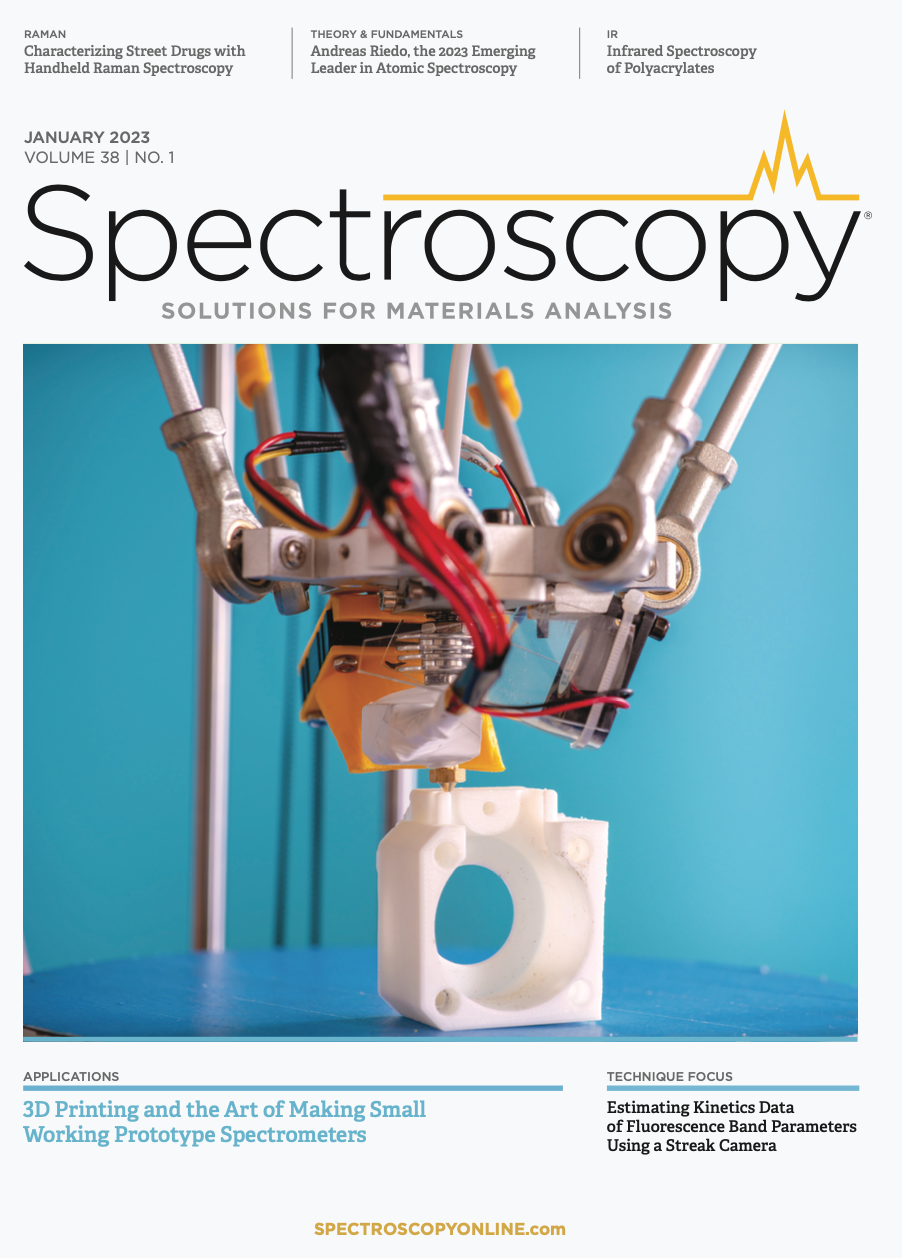
LIBS Illuminates the Hidden Health Risks of Indoor Welding and Soldering
April 23rd 2025A new dual-spectroscopy approach reveals real-time pollution threats in indoor workspaces. Chinese researchers have pioneered the use of laser-induced breakdown spectroscopy (LIBS) and aerosol mass spectrometry to uncover and monitor harmful heavy metal and dust emissions from soldering and welding in real-time. These complementary tools offer a fast, accurate means to evaluate air quality threats in industrial and indoor environments—where people spend most of their time.
Trends in Infrared Spectroscopic Imaging
September 13th 2013An interview with Rohit Bhargava, winner of the 2013 Craver Award. This interview is part of the 2013 podcast series presented in collaboration with the Federation of Analytical Chemistry and Spectroscopy Societies (FACSS), in connection with SciX 2013, the federation?s North American conference.